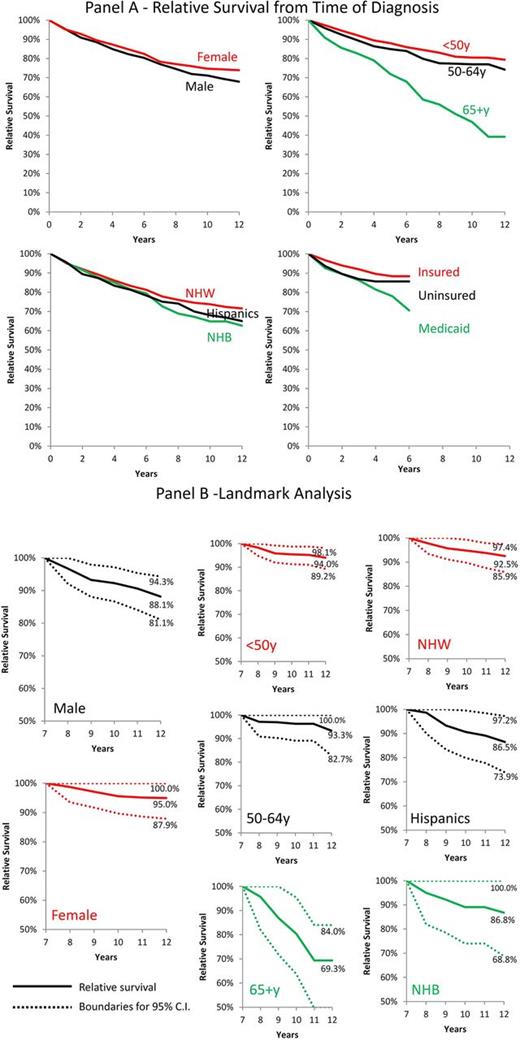Abstract
Background:
Chronic myelogenous leukemia (CML) is a myeloproliferative neoplasm characterized by the presence of the BCR-ABL fusion gene resulting in activation of the ABL tyrosine kinase. Treatment of CML has been revolutionized by the introduction of ABL tyrosine kinase inhibitors (TKI) since 2001, leading many patients to reach deep remissions. Recent reports based on clinical trial series and international registries suggest that a substantial subset of CML patients treated with TKIs may have similar survival to that of the general population, but those studies are somewhat limited by the small sample size, possible selection bias or less diverse population. We intend to compare the survival of US patients with CML with the general population.
Methods:
We utilized the Surveillance, Epidemiology and End Results 18 (SEER 18) registries to select adult patients diagnosed with BCR-ABL positive CML between 2001 (introduction of TKIs) and 2014 (most recent year with follow up available). Cases with unknown age or survival data and those informed only by autopsy or death certificate were excluded. For different subsets of patients we described relative survival (RS), the ratio between actual survival of CML patients and the survival expected in a population, with same age, sex, race/ethnicity characteristics. We subsequently performed sensitive analysis to identify a time landmark beyond which CML patients are expected to have survival more closely resembling the survival of the general population. These analyses were performed for different sex, age, race/ethnicity and insurance-status subsets. Analysis per insurance-status was partially limited by unavailability of this information for cases diagnosed before 2007. The analysis was performed using the survival function in SEER*Stat v 8.3.4.
Results:
There were 3,946 patients included in the analysis with a median follow up of 72 months. Of these, 2,253 (57.1%) were males and 1,693 (42.9%) were females; 1,738 patients (44.0%) were younger than 50 years of age, 1,204 (30.5%) were between ages 50 and 64, and 1,004(25.4%) were 65 or older. There were 2,514 (63.7%) Non-Hispanic Whites (NHW), 602 (15.2%) Hispanics and 426 (10.8%) Non-Hispanic Blacks (NHB). Relative survival for the different subsets is displayed in the Figure, panel A. Ten year RS for male patients was 71.1% (95% C.I. 66.8%-74.9%) vs 74.7% (95% C.I. 70.2%-78.7%) for female patients (P=0.118). Ten year RS for patients 65 or older was 46.9% (95% C.I. 37.3%-55.9%), inferior to RS of patients younger than 50 (80.5%, 95% C.I. 77.1%-83.4%, P<0.001) and to RS of patients 50-64 (77.0%, 95% C.I. 71.2%-81.8%, P<0.001). There was no significant difference in RS at 10 years according to race/ethnicity, reaching 73.7% (95% C.I. 69.8%-77.2%) for NWH, 68.0% (95% C.I. 60.0-74.7%, P=0.09 for comparison with NHW) for Hispanics and 64.8%(95% C.I. 53.8%-73.8%, P=0.05 for comparison with NHW) for NHB. RS at 6 years from diagnosis was 88.4% (95% C.I. 85.4%-90.8%) for insured patients vs. 85.7% (95% C.I. 77.0%-91.3%, P=0.237 for comparison with insured) for uninsured patients and 70.6% (95%, C.I. 61.3%-78.2%, P<0.001 for comparison with insured) for Medicaid beneficiaries. Sensitive analysis identified 7 years from diagnosis as the time landmark that best identifies patients with subsequent survival resembling the general population (Figure, panel B). Seven-year survivors of CML have 12-year RS that approaches 100% for most subsets, except males and patients 65 and older.
Conclusion:
RS of CML patients in US is not similar to the general population possibly influenced by outcomes disparities by age and insurance status. For 7-year survivors of CML, subsequent survival approaches the general population for younger and female patients.
No relevant conflicts of interest to declare.
Author notes
Asterisk with author names denotes non-ASH members.


This feature is available to Subscribers Only
Sign In or Create an Account Close Modal